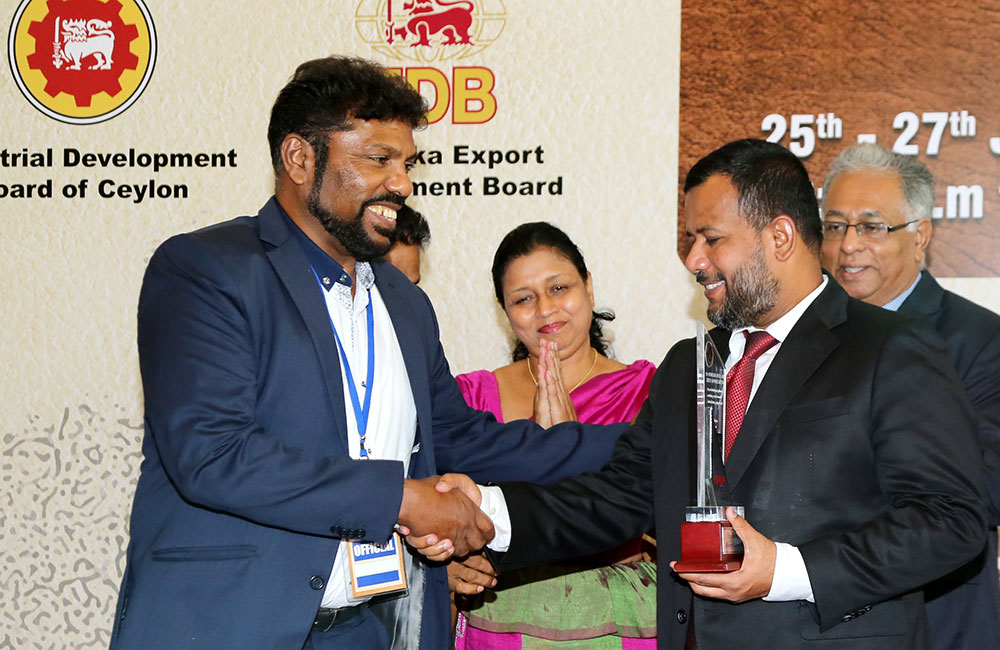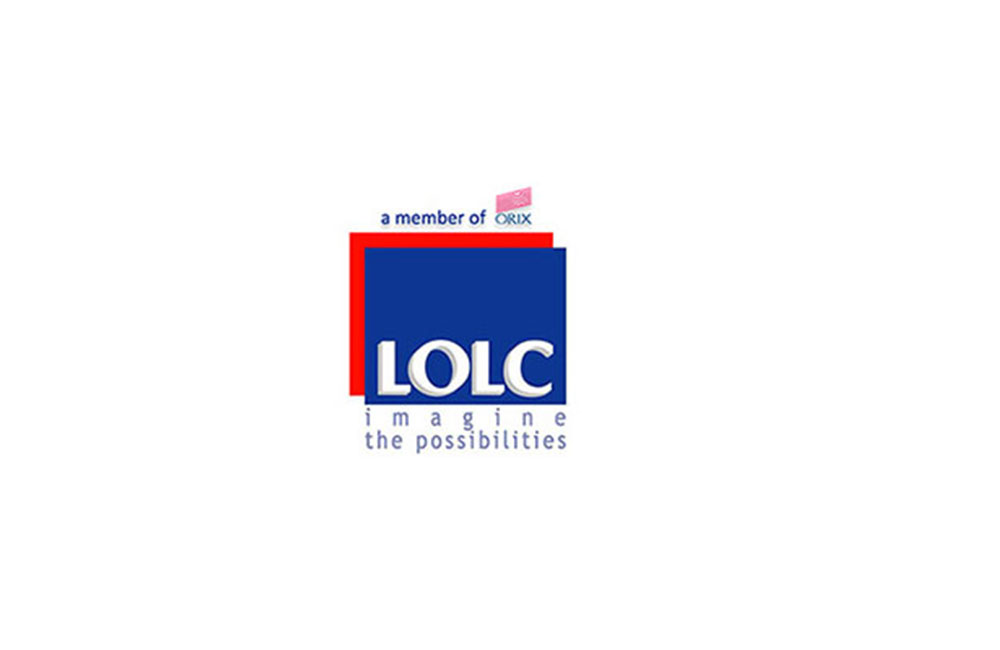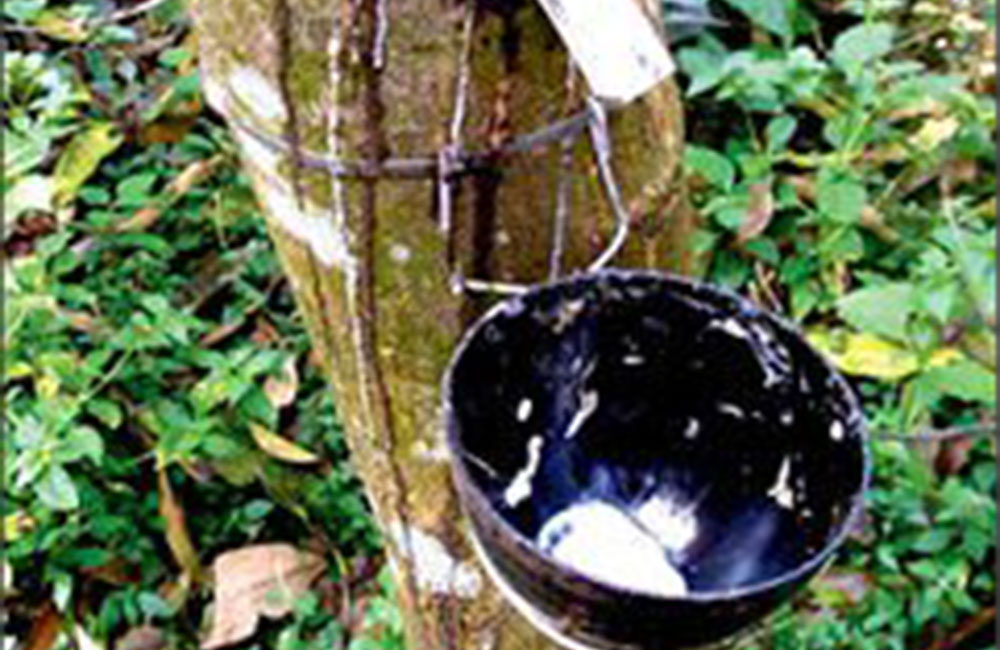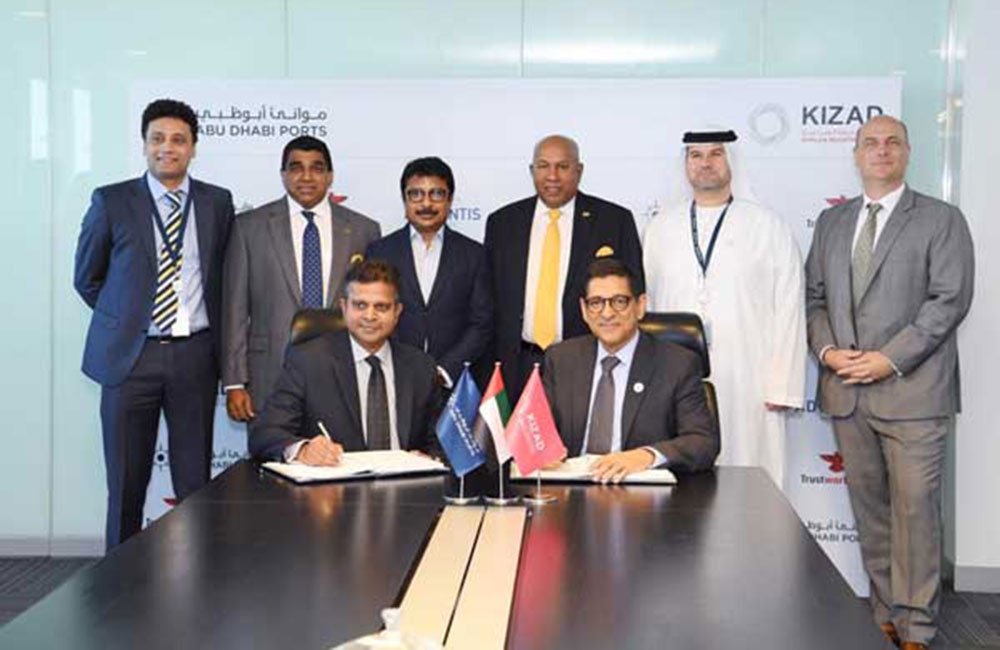Business

Footwear and leather export sector transforms into a vibrant export industry
Sri Lanka's US$550 million footwear and leather export sector has now been transformed to a vibrant export competitive industry with the assistance of the ministry of industry and commerce on the directions of Minister Rishad Bathiudeen Rishad Bathiudeen.
This compliment was paid by the President of Sri Lanka Footwear and Leather Products Association P.G.D Nimalasiri when he delivered the welcome address at the awards ceremony of 11th Sri Lanka Footwear and Leather fair in Colombo on Monday 27.
The import cess for shoe parts has been increased to Rs 600 from Rs 300 while resolving issues faced by leather tanners by the treasury on the directions of the ministry, he said.
The ministry is also considering the establishment of special leather industry and tanning zone. Sri Lanka’s first ever footwear and leather training course series has been implemented with the Sri Lanka Institute of Textile & Apparel (SLITA) under the Industry Ministry.
Footwear and Leather Products Industry is Rs 100 Billion sector and has great potential in years to come. The footwear and leather sector operators paid a tribute to minister Bathiudeen for his invaluable support and services rendered to the industry, he added.
Sri Lanka’s footwear and leather sector employ around 300,000 and according to SLFLPMA’s President Nimalasiri, its annual production is estimated at around the US $ 550 Mn (Rs 100 Billion). It’s among the leading forex-saving industries in the country. The sector involves all scales of Lankan operators.
According to the Export Development Board (EDB), its exports have surged by 300 per cent in the ten year period from 2008 to 2018. In 2018, its exports totalled the US $ 119 Million. 48% of it was bought by Vietnam and 16% by the UK. Around the US $ 900,000 of Lankan footwear were also bought by the US (2018).

LOLC strengthens presence in the Asian market
LOLC, one of the largest and most diversified conglomerates in the country is now strengthening its presence in the growing Asian market with the continuing of operations in Myanmar , Cambodia , Pakistan , Indonesia and the Philippines .
The company also explores the possibility of launching its operations in India and Zambia while using strong fundamentals to enter into several other regional financial service markets.
Lanka Orix Leasing Company PLC (LOLC) has changed its name to LOLC Holdings PLC recently with the exit of Japan's Orix Corporation in March 2018 after almost four decades.
It has diversified its portfolio from financial services and non-financial services to leisure, plantations, agri-inputs, renewable energy, construction as well as manufacturing and trading at present.
In line with the Group's diversification strategy, the company will open 160 roomed super five star hotel in Kosgoda in March next year in a tie up with Sheraton Group making a significant value addition to Sri Lanka’s leisure sector.
The Group is actively engaged in the construction sector through the Sierra Group, Trading and Manufacturing through the Browns Group and Asia Siyaka, Agriculture and Plantation through Maturata, Pussellawa, Gal-Oya and Agstar Fertilizers and the renewable energy sector through United Dendro and Hydropower Free Lanka.
With a 63% increase in Group revenue reaching Rs. 150Bn, LOLC has evolved to become the Number 1 Financial Conglomerate in Sri Lanka in the recently released LMD 100 rankings. Having launched its operations in 1980 as a company with a sharp eye on the future and the ability of reading the times with accuracy, LOLC opened its doors to provide what was then Sri Lanka 's pioneer portfolio of leasing solutions to an eager market.
After 38 years, LOLC has rapidly evolved into being the country’s biggest non-banking financial institution and one of the biggest and most diversified conglomerates in the country.

Swiss made medicinal cannabis product to debut in Sri Lanka
Any Sri Lankan that requires the use of medicinal cannabis (marijuana) products for health or therapeutic reasons will be able to buy it from local pharmacies, with the drug poised to launch its debut in the local market soon.
Medicinal cannabis manufacturer Creso Pharma Limited (CHP) has inked a binding letter of intent with leading Sri Lankan pharmaceutical distributor Ceyoka Health to expand its medicinal cannabis products into the island nation recently, the company announced.
The partnership will initially obtain the necessary regulatory acceptance from local authorities for Creso’s cannAFFORD-50, a CBD lozenge designed to treat chronic pain, before marketing other joint initiatives in the medicinal cannabis field.
The partners have also agreed to establish a comprehensive New Zealand-based cannabis business in the island to explore local research and development activity, domestic cultivation, extraction and product development for meeting domestic and international demand.
It will explore a wide range of other joint initiatives focusing on innovative therapeutic and medicinal products containing hemp extracts.
This product has been developed according to good manufacturing practice standards and is produced in Switzerland by Creso’s partner Swiss-based food and pharma development company, Domaco to the highest Swiss quality with a “Swiss Made” label.
There are an estimated 600,000 cannabis users in the country and medicinal marijuana is legal at pharmacies that hold a license from the Ministry of Health.
There is some domestic cultivation, but it also relies on imports and Creso Pharma is aiming to establish itself as a leading light in the country, foreign news agencies highlighted.
Ceyoka Health is one of the leading pharmaceutical distribution companies in Sri Lanka, with a distribution network of more than 1,800 pharmacies. Creso Pharma and Ceyoka Health plan to work together on a number of joint initiatives to provide Sri Lankans with hemp-based products.

Pine Capital signs MOU to develop land in Sri Lanka
Financial services firm Pine Capital Group has signed a memorandum of understanding (MOU) with the Provincial Council of the Eastern Province of Sri Lanka to invest in and develop an extent of land in Eastern Province, Sri Lanka.
Pine Capital said it envisions an integrated hospitality and lifestyle township comprising luxury resorts, hotels, serviced apartments, an international fashion design institute and a convention centre to cater for fashion and lifestyle events.
The total investment amount in the project, called Project Beacon, is conservatively expected to be at least US$3 billion.
Pine Capital said in a Singapore Exchange filing: "The board considers that the MOU, in line with the group's business strategy, expansion plan and diversification of its core business to include project management, will offer a good opportunity for the group to broaden its business, revenue base and generate direct cash flow to the company in the future."

93 Fife Residencies – Super Luxury Living Redefined in Colombo
The ground-breaking ceremony of the striking new residential development, 93 Fife Residencies, was held on-site at Fife Road, Colombo 05.
The super luxury apartments are designed to meet the rising demand for exclusive new age living in Colombo.
Owned and guided by the leadership of New Delmon Hospitals, the apartment complex will be built on a privately owned property spanning 40 perches of land in Colombo 05, one of the city’s rapidly progressing commercial hubs.
“Our aim is to bring unrivalled modern living options to the deserving residents in Colombo,” stated Director of 93 Fife Residencies Private Limited Mr. Mustaqdeenin his welcome speech. “93 Fife Residencies begins a new chapter in the story of our companies, and also in the lives of the people who will make their homes here.”
93 Fife Residencies draws inspiration from a vision to create exclusive, elegant and elite living structures, adding value and aesthetic to Colombo’s ever-evolving skyline. A total of 40 limited-edition luxury units will be available in the 10-storey structure, with 4 residential units on each floor.
The architecture and integrated design for this luxurious property comes from the team of experts at Surath Wickramasinghe Associates, led by renowned Architect and Planner, Dr. Surath Wickramasinghe.
According to the owner and Director of 93 Fife Residencies Private Limited, Mowjood Mohamed Mohinudeen, the project is a realization of a passion for construction he had for decades.

Hayleys Group ranked No. 1 in LMD Top 20
Hayleys PLC, maintained its position at the forefront of Sri Lanka’s corporate sector by becoming No.1 in the 25th edition of the LMD Top 20 for the second consecutive year.
The announcement of the LMD Top 20 was made at a time when Hayleys is celebrating 140 years of innovation and business excellence in Sri Lanka. This year’s ranking also amounts to the fourth occasion that Hayleys has occupied the prime position in Sri Lanka’s version of the Fortune 500.
Over the course of the last financial year Hayleys became the first listed company in Sri Lanka to achieve US$ 1 billion turnover, representing a 47% Year-on-Year (YoY) improvement whilst the group’s extensive range of exports accounts for 3.3% of the nation’s total export earnings.
Hayleys PLC’s top ranking in this year’s LMD Top 20 is the latest in a long series of prestigious accolades to the group, which was once again declared among LMD’s Top 3
Most Respected Corporates in Sri Lanka, in addition to securing a place in the inaugural Top 10 Most Admired Companies in Sri Lanka by the International Chamber of Commerce, Sri Lanka (ICCSL) and the Chartered Institute of Management Accountants (CIMA) Sri Lanka.
Catering to over 7.6 million customers world-wide, the Hayleys Group today stands as one of Sri Lanka’s vibrant corporate entities, providing direct employment to 32,000 Sri Lankans, in addition to providing indirect employment to over 20,000 people.
Following its establishment in 1878 as a trading house for the import of valuable goods, and export of locally produced goods such as spices, coir yarn and essential oils; the group has rapidly expanded in the scope and scale of its operations. Today, Hayleys maintains a global presence across 5 continents with business interests spanning a total of 16 sectors.

SLT announce new CEO and COO
Sri Lanka Telecom (SLT) announced the appointment of K.A. Kiththi Perera as SLT's new Chief Executive Officer (CEO) while M.B.P. Fernandez was appointed as the Chief Operating Officer (COO).
Perera joined SLT in 1994 and he played significant leadership roles in various departments with increasing responsibilities for nearly 24 years.
He earned a Masters in Engineering from the University of Moratuwa in Electronics and Telecommunications Engineering and is a Chartered Engineer of the Engineering Council (UK) and Institution of Engineering and Technology (UK).
As a key member of its initial management team, he helped in planning, designing and developing of data access networks based on G.SHDSL, metro ethernet and digital radio access technologies. In 2005, SLT appointed Perera as Project Manager of Bharat Lanka Submarine Cable System project where he involved in high level design of first repeaterless submarine cable system (with RA amplifiers and DWDM technology) in South Asia.
As a professional in telecommunication industry, he achieved many awards including the Gold Award (for senior management category) in SLT Transformers Awards in 2014. He also represented SLT in many national and international fora and professional bodies.
Perera has been a Non-Executive Director of Sri Lanka Telecom (Services) Ltd., since 2007.
Meanwhile, new COO of SLT, M.B.P. Fernandez holds a BSc (Eng.) in Electronics and Telecommunications from the University of Moratuwa and an MBA from the University of Sri Jayewardenepura. He is a Chartered Engineer and a Fellow of The Institution of Engineers Sri Lanka.
Fernandez joined SLT in 1991. Following his roles in various multinational telecommunication organizations, he has held a string of senior positions within SLT, culminating to his current position as the Chief Operating Officer. In this role, he oversees the entire planning, operation, sales and maintenance of SLT network and projects of SLT in Sri Lanka. In addition, he has overseen the design implementation and operation of SLT network and projects of SLT in Sri Lanka.
He has played a leading role for planning and deploying very large scale programmes for SLT network transformation. New Generation Network (NGO), Sri Lanka Backbone Network (SLBN), Fiber to The Home (FITH). LTE(4G), National Broadband Programme (i-Sri Lanka), National Data Centre, and Submarine Cable Systerms are some of the flagship projects in which he made his contributions felt. Fernandez is a permanent member of the Technical Subcommittee of SLT since 2011 and a member of the Senior Tender Board.

35 percent interest rate cap on Sri Lanka’s microfinance industry
Central Bank has introduced a maximum rate of interest for microfinance loans with the aim of protecting customers being charged exorbitant interest rates on microfinance loans granted by Licensed Finance Companies (LFCs).
LFCs should not charge a rate exceeding 35 percent per annum, inclusive of all other charges on micro finance loans, a directive issued by the country’s monetary authority under the Finance Business Act revealed recently.
Former Minister of Finance and Media Mangala Samaraweera allocated approximately LKR 1 billion to write-off microfinance loans up to LKR100,000 taken by 75,000 women in drought-affected 12 districts.
According to Samaraweera, 70-90 percent of rural population in the North, East, North West and North Central rely on micro credit, given the limited access to credit from banks, at an exorbitant interest between 40-220 percent.
"We have information that certain young women are being forced to pay debt with sexual favours. It’s a very sad, tragic and desperate situation in which the government felt it had an inherent moral duty to intervene. So, that’s why we took a historic step of writing-off debt of nearly 75,000 women at the first phase,” Samaraweera said in August.
As such, microfinance and finance companies have agreed to cap annual interest rates at 35 percent for all new loans, a senior Central Bank official said. But several CEOs of licensed finance companies noted that this directive will increase operational cost of companies due to the cut down of interest rates adding that their human resources will also need to be cut down which will negatively affect all their employees.
Capping the interest rate at 35 percent will further affect the cash flow of finance companies from small loans, which comprise a large percentage of their loan portfolio, they added.
There is an estimated LKR 140 billion of loans below LKR 100,000 from finance companies to small borrowers in all districts, not counting unregulated micro-lenders, according to finance ministry’s latest statistics.
This latest 35 percent cap on interest will compel many finance companies to stop offering small loans; rural areas will miss out billions of rupees in money circulation a year, and rural poor will be forced to turn to moneylenders who charge far more than micro finance institutions, they claimed.
They stressed that finance companies contribute a massive amount to government coffers by way of taxes and a reduction in the interest cap would also affect the tax income earned. Therefore, they said that the Central Bank should look at least capping the interest rate at 40 percent.

Danish firm to build Sri Lanka's first large-scale wind farm
Danish wind turbine manufacturer Vestas Wind Systems has secured an order to build Sri Lanka's first large-scale wind farm, the Mannar, CEB sources said.
Vestas Wind Systems has said it has been selected by Ceylon Electricity Board (CEB) to install the Mannar wind farm. The engineering, procurement and construction (EPC) contract had been obtained in an international tender which included the delivery, installation and commissioning of 30 V126-3.45 MW turbines, as well as civil and electrical works.
Vestas will install Sri Lanka’s first large-scale wind park, the 104-megawatt (MW) Mannar Wind Power Project, the Danish wind giant announced recently. The Engineering, Procurement and Construction (EPC) contract was awarded by Ceylon Electricity Board (CEB), the main utility company of Sri Lanka, in an international tender, according to a statement from Vestas. The project, which was conceived by CEB and is fully funded by Asian Development Bank (ADB), marks the return of Vestas to Sri Lanka after 19 years, the press release said.
The project will also include a full-scope Active Output Management 4000 (AOM 4000) service agreement as well as the Vestas Online Business SCADA solution lowering turbine downtime to optimize the energy output.
"We are very excited with this order and the opportunity to be back in Sri Lanka," said Clive Turton, president of Vestas Asia Pacific. "This tender signifies a clear indication of CEB and local policymakers' intention to promote sustainable energy sources as well as increase the mix of sustainable energy in the local grid.
Vestas looks forward to working together with our local partners and the local authorities towards this common goal," he added.
Construction is expected to begin in the first quarter of 2019, and the project is expected to be completed in the third quarter of 2020.

Sri Lanka’s rubber production dwindles with no budget support in 2019
Sri Lanka’s rubber production reported a decline due to lower auction prices and its exports are to be affected as a result of the current political impasse.
Production of rubber also declined considerably due to lower auction prices, the Central Bank announced pointing out it will further come down due to the present political instability in the country.
Rubber production has dropped by 3.54 percent to 67.76 million kilograms during the first ten months of this year from 70.24 million kilograms in the same period last year.
Sri Lankan manufacturers of natural rubber products have made a proposal to the government to allocate more money for rubber cultivation in its budget for 2019 to revive the dwindling production.
2019 budget prepared by the finance ministry on the directions of ousted finance minister Mangala Samaraweera was considering to make necessary financial allocation for this purpose at the time of the president’s action., informed sources said.
2019 budget prepared by the Ministry of Finance, on the directions of ousted Finance Minister Mangala Samaraweera, was considering to make the necessary financial allocation for this purpose, informed sources from the Treasury said.
However, this is unlikely to be materialized due to president Sirisena's arbitrary action to sack the legitimately elected ruling party preventing the presentation of 2019 budget.
Sri Lanka Podujana Peramuna (SLPP) Chairperson Prof. G.L Peiris yesterday acknowledged the need for the allocation of funds for next year, conceding that only the Parliament was vested with the authority to allocate public funds for government entities and reiteretated that this could not be done by the Executive.
The Sri Lanka Association of Manufacturers and Exporters of Rubber Products (SLAMERP) said rubber industry is the fourth largest export sector in the country with total sales of almost a billion dollars.
Sri Lanka’s rubber product exports stood at USD 855 million In 2017, up by about 11% from the year before.
The government should launch a programme immediately to revive the natural rubber production which had fallen to 83.1 million kilograms in 2017 from 130 million kilograms in 2013, officials said.

Lack of regulatory mechanisms hinder micro-insurance growth in Sri Lanka
A major constraint hindering the growth of the microinsurance sector is the lack of policies and regulatory mechanisms to facilitate microinsurance, says a recent report produced by the International Cooperative and Mutual Insurance Federation (ICMIF) and the Institute of Policy Studies of Sri Lanka (IPS).
Reviews of available literature, as well as discussions with suppliers of micro-insurance providers agree that the lack of provisions in insurance law for microinsurance in Sri Lanka is a major concern.
The report entitled “ Country diagnostic on mutual and cooperative microinsurance in Sri Lanka” says that current regulatory requirements are arguably more suitable for traditional providers and could be considered too stringent in the case of smaller scale microinsurance providers. According to a study conducted by BASIX Consulting (2016), minimum capital and reinsurance requirements have prevented registered insurers from entering the microinsurance market.
Insurers which are currently involved in microinsurance also find these stringent regulations to be a disincentive to expanding these microinsurance activities. For example, additional high costs associated with recently introduced regulatory requirements such as Risk Based Capital (RBC) regulations, and the segregation of life and general insurance businesses were cited by microinsurance providers as key regulatory hurdles deterring them from expanding their low-premium business ventures. These concerns were shared by the formal cooperative and mutual microinsurance providers in Sri Lanka.
The prospects for insurance business expansion are rather limited for these micro-insurance organisations. A key reason for this is their reluctance to partner with formal insurance providers. Many informal, community-based organisations feel that the profit-maximising outlook of formal insurance companies is potentially damaging to their welfare-maximising endeavours.
The government’s presence in the microinsurance industry is also seen as to be a deterrent to expanding micro-insurance business. For example, AAIB, the main role of which is to provide agricultural insurance has now entered the motor insurance market as well, while the national reinsurer, NITF has also entered the market as an insurance provider. Insurance companies in the private sector find it difficult to compete with such government bodies that can provide services at subsidised prices.
Furthermore, low income households are habitually highly reliant on government assistance in times of disaster; they expect government aid as a matter of course, and thus are not motivated to purchase insurance to face possible risks.
In addition to the government’s assistance, low-income households were found to be highly reliant on community-based networks as a risk management strategy. The high level of social organisation in village communities points to the availability of room for growth for mutual and cooperative microinsurance providers, yet to be fully exploited.
The low demand for insurance among low-income households also contributes to impeding the growth of the microinsurance industry. A major reason for the low demand is the lack of insurance awareness among low income households. Additionally, these households express high levels of mistrust towards insurance companies due to past experiences.
Furthermore, the microinsurance industry targets the low-income households which can often be characterised by highly irregular and seasonal income patterns; the inability of such households to commit to periodical premium payments has also contributed to shrinking their demand for insurance.

Hayleys set to operate 1.4 mn sq-ft facility in Abu Dhabi
Dubai-based Trustworthy.ae Group is set to invest Dh365 million (USD 100 million) in Khalifa Industrial Zone Abu Dhabi (Kizad), to develop an inland container depot (ICD), a third-party container freight station (CSF) and other port-related services over the next five years with Hayleys Advantis Limited, the transport and logistics arm of Sri Lanka’s Hayleys Group, signing on to operate the facility.
Kizad is one of the largest industrial zones in the Middle East and a subsidiary of Abu Dhabi Ports.
Construction on the container freight station and inland container depot, which will be developed on a 1.4 million sq ft land plot, will commence in January 2019 and is set to become operational by June 2019.
“As the leading logistics solutions provider in Sri Lanka, Hayleys Advantis Limited is happy to enter into this landmark partnership with Trustworthy.ae Group, stepping into the Middle East market after having already established its presence in over ten countries," Hayleys PLC chairman Mohan Pandithage said
“It gives us great pride to represent and work with many of the large shipping and freight companies in the world and we look forward to a fruitful partnership with Trustworthy.ae Group to build a world-class operation in Kizad using our diverse and in-depth expertise,” he added.
Hayleys is the first Sri Lankan-listed company to cross USD 1 billion in turnover in fiscal year 2017/18.
Page 17 of 28